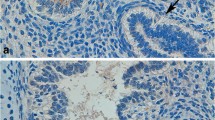Abstract
This study investigated the expression of lung surfactant proteins (SP-B and SP-C), and regulatory factors [forkhead box A2 (FOXA2) and nitrolyogenic FOXA2 (N-FOXA2)] in the fetal lung of rats with gestational diabetes mellitus (GDM) in order to study the mechanism of pulmonary dysplasia. The rat GDM model was established by using streptozotocin intraperitoneally in the first stage of pregnancy. There were 10 rats in the GDM group, and 10 healthy rats in normal control group without any treatment. Fetal lungs of two groups were taken at day 21 of pregnancy. Blood glucose levels of maternal rats and fetal rats were measured by Roche blood glucose meter. The histological changes in the fetal lung were observed under the light microscope in both groups. The SP-B, SP-C and FOXA2 were determined in the fetal lung of two groups immunohistochemically. The expression levels of SP-B, SP-C, total FOXA2, FOXA2 in nucleus (n-FOXA2), N-FOXA2 proteins were detected by Western blotting, and the relative expression levels of SP-B, SP-C, FOXA2 mRNA in the fetal lung of two groups were detected by RTPCR. The results showed that blood glucose levels of maternal rats and fetal rats in GDM group were higher than those in control group. The light microscope revealed fetal lung development retardation in GDM group. The expression of SP-B and SP-C in GDM group was significantly reduced as compared with control group (P<0.05). As compared with control group, the n-FOXA2 expression was significantly decreased in the fetal lung tissue, and N-FOXA2 was significantly increased in control group (P<0.05), but there was no significant changes in the total FOXA2 (P>0.05). It was concluded that GDM can cause fetal lung development and maturation disorders, and FOXA2 in fetal lung tissue decreases while nitrocellulose FOXA2 increases.
Similar content being viewed by others
References
Morrisey EE, Hogan BL. Preparing for the first breath: genetic and cellular mechanisms in lung development. Dev Cell, 2010,18(1):8–23
Wolfrum C, Asilmaz E, Luca E, et al. Foxa2 regulates lipid metabolism and ketogenesis in the liver during fasting and in diabetes. Nature, 2004,432(7020):1027–1032
Jimenez FR, Belgique ST, Lewis JB, et al. Conditional pulmonary over-expression of Claudin 6 during embryogenesis delays lung morphogenesis. Int J Dev Biol, 2015,59(10–12):479–485
Sun L, Tang XJ, Luo FM. Forkhead box protein A2 and T helper type 2-mediated pulmonary inflammation. World J Methodol, 2015,5(4):223–229
Ortega-Senovilla H, Schaefer-Graf U, Meitzner K, et al. Gestational diabetes mellitus causes changes in the concentrations of adipocyte fatty acid-binding protein and other adipocytokines in cord blood. Diabetes Care, 2011,34(9):2061–2066
Vignoles P, Gire C, Mancini J, et al. Gestational diabetes: a strong independent risk factor for severe neonatal respiratory failure after 34 weeks. Arch Gynecol Obstet, 2011,284(5):1099–1104
Catalano PM, McIntyre HD, Cruickshank JK, et al. The hyperglycemia and adverse pregnancy outcome study: associations of GDM and obesity with pregnancy outcomes. Diabetes Care, 2012,35(4):780–786
Fung GP, Chan LM, Ho YC, et al. Does gestational diabetes mellitus affect respiratory outcome in latepreterm infants? Early Hum Dev, 2014,90(9):527–530
Yang P, Cao Y, Li H. Hyperglycemia induces inducible nitric oxide synthase gene expression and consequent nitrosative stress via c-Jun N-terminal kinase activation. Am J Obstet Gynecol, 2010,203(2):185 e5–11
Kurtz M, Martinez N, Capobianco E, et al. Increased nitric oxide production and gender-dependent changes in PPARalpha expression and signaling in the fetal lung from diabetic rats. Mol Cell Endocrinol, 2012,362(1–2):120–127
Hao Y, Kuang Z, Xu Y, et al. Pyocyanin-induced mucin production is associated with redox modification of FOXA2. Respir Res, 2013,14:82
Deng FT, Zhang L, Ge LF, et al. Fetal lung structures and expression of pulmonary surfactant proteins of B and C and their modulating factors in rat with gestational diabetes mellitus. Chin J Perinatal Med (Chinese), 2015,18(8):625–631
Rees DA, Alcolado JC. Animal models of diabetes mellitus. Diabet Med, 2005,22(4):359–370
Warburton D. Overview of Lung Development in the Newborn Human. Neonatology, 2017,111(4):398–401
Jimenez FR, Lewis JB, Belgique ST, et al. Developmental lung expression and transcriptional regulation of claudin-6 by TTF-1, Gata-6, and FoxA2. Respir Res, 2014,15:70
Whitsett JA, Matsuzaki Y. Transcriptional regulation of perinatal lung maturation. Pediatr Clin North Am, 2006,53(5):873–887
Chung C, Kim T, Kim M, et al. Hippo-Foxa2 signaling pathway plays a role in peripheral lung maturation and surfactant homeostasis. Proc Natl Acad Sci USA, 2013,110(19):7732–7737
Wan H, Xu Y, Ikegami M, et al. Foxa2 is required for transition to air breathing at birth. Proc Natl Acad Sci USA, 2004,101(40):14 449–14 454
Wan H, Kaestner KH, Ang SL, et al. Foxa2 regulates alveolarization and goblet cell hyperplasia. Development, 2004,131(4),953–964
Mavromatakis YE, Lin W, Metzakopian E, et al. Foxa1 and Foxa2 positively and negatively regulate Shh signalling to specify ventral midbrain progenitor identity. Mech Dev, 2011,128(1–2):90–103
Wan H, Dingle S, Xu Y, et al. Compensatory roles of Foxa1 and Foxa2 during lung morphogenesis. J Biol Chem, 2005,280(14):13 809–13 816
Deng FT, Ouyang WX, Ge LF, et al. Expression of lung surfactant proteins SP-B and SP-C and their modulating factors in fetal lung of FGR rats. J Huazhong Univ Sci Technolog Med Sci, 2015,35(1):122–128
Hua KF, Wang SH, Dong WC, et al. High glucose increases nitric oxide generation in lipopolysaccharide-activated macrophages by enhancing activity of protein kinase C-alpha/delta and NF-kappaB. Inflamm Res, 2012,61(10):1107–1116
Kurtz M, Capobianco E, Careaga V, et al. Peroxisome proliferator-activated receptor ligands regulate lipid content, metabolism, and composition in fetal lungs of diabetic rats. J Endocrinol, 2014,220(3):345–359
Author information
Authors and Affiliations
Corresponding author
Additional information
This work was supported by grants from the National Natural Science Foundation of China (No. 30971072) and the Natural Science Foundation of Hubei Province (No. 2017CFB749).
Rights and permissions
About this article
Cite this article
Zhang, Qm., Ouyang, Wx., Chai, Xq. et al. Expression of Lung Surfactant Proteins SP-B and SP-C and Their Regulatory Factors in Fetal Lung of GDM Rats. CURR MED SCI 38, 847–852 (2018). https://doi.org/10.1007/s11596-018-1952-8
Received:
Revised:
Published:
Issue Date:
DOI: https://doi.org/10.1007/s11596-018-1952-8




